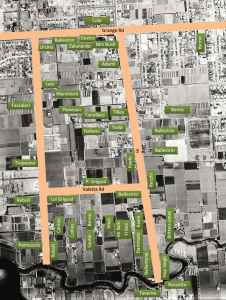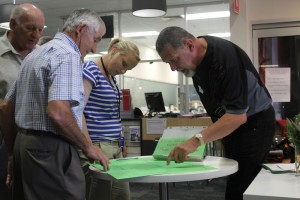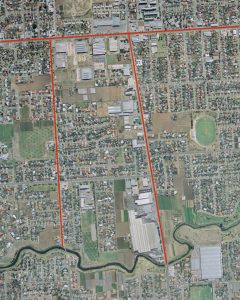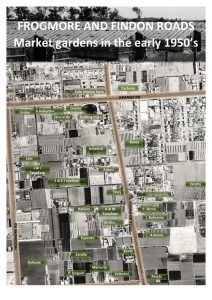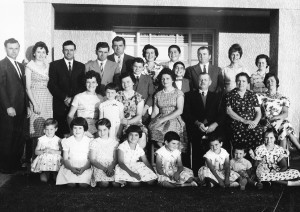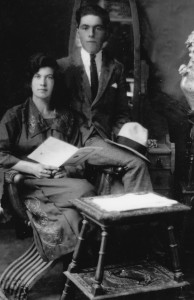
The 18 pioneer market gardeners arrived in Adelaide between March 1926 and January 1928. The sons and daughters interviewed for the project know some details of their fathers’ early days in Australia. Francesco and Margherita Marchioro were the first arrivals in March 1926. Margherita’s brother, Florindo, who had a terrazzo business, sponsored them. The couple lived with their six-month old daughter, Mary, in Hindley Street in the city of Adelaide and Francesco worked for his brother-in-law, Florindo. After six or seven years they leased land on Frogmore Road for a market garden. Margherita grew vegetables there with her brother-in-law, Vittorio from about 1932 or 1933.
The pioneers arrive in 1927
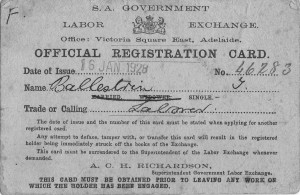
In South Australia in 1927, the Depression had begun and it was difficult to find work. After they arrived, the men from the Veneto looked for employment where they could find it. Isidoro Ballestrin went to Finke about 1,000 km away in the Northern Territory to sink wells. His cousin Giuseppe Ballestrin aged 17, worked for a time at Wallaroo Fertiliser at Port Adelaide. Vittorio Marchioro worked for an Italian man in Victoria cutting wood for a while. Angelo Piovesan built roads at Karoonda for Bernardi, a Veneto man from Bigolino. Giovanni Santin went to Wellington on the River Murray and worked for a German dairy farmer. Bruno Rebuli worked on Kangaroo Island possibly as a farm worker and Silvano Zampin worked in the country. We do not know about what the other men did when they first arrived in South Australia in the late 1920s.
Establishing farms, leasing land
When did the first veneti establish their farms on Frogmore Road and Findon Road? In their oral history interviews, the sons and daughters of the pioneers know that their fathers first leased land and gradually built up their market gardens buying second-hand glass houses and horses to help with working the land. Some of the interviewees remember as children going to the large house of the owner to pay the rent on behalf of their parents. Only Gino Berno was able to buy land before World War II. Because of Australia Government regulations, Italians had to wait until after the war to buy land. Most of the veneti bought the land they had been leasing for their family market garden business.
I primi anni degli orticoltori veneti
I pionieri orticoltori arrivarono ad Adelaide tra il marzo 1926 e il gennaio 1928. I figli e le figlie che sono state intervistate per il progetto sanno alcuni detagli dei loro inizi in Australia. Francesco e Margherita Marchioro sono stati i primi ad arrivare in marzo 1926. Il fratello di Margherita, Florindo che ebbe avuto una attività commerciale dove faceva “terrazzo”, ha richiamato Francesco e Margherita. La coppia viveva con la figlia di sei mesi, Mary, nella città di Adelaide e Francesco lavorò per suo cognate, Florindo. Dopo sei or sette anni hanno affittato il terreno in Frogmore Road per coltivare le verdure. Margherita lavorò con suo cognato Vittorio dal 1923 in sù.
I pionieri arrivano nel 1927

Nel 1927 nel Sud Australia, la depresione era appena iniziata ed era molto difficile trovare lavoro. Dopo il loro arrivo gli uomini del Veneto cercarono lavoro ovunque lo trovassero. Isidoro Ballestrin andò a Finke circa 1,000 chilometri a nord di Adelaide nel Northern Territory per scavare i pozzi. I fratelli Berno lavorarono nelle colline vicino Adelaide. Giuseppe Ballestrin che aveva 17 anni lavorò per qualche tempo in un azienda di fertilizzanti a Port Adelaide. Vittorio Marchioro lavorò per un uomo Italiano in Victoria ad abbattare gli alberi per un pò di tempo. Angleo Piovesan costruì le strade a Karoonda (circa 150 chilometri da Adelaide) per Bernardi, un Veneto da Bigolino. Giovanni Santin andò a Wellington, circa 100 chilometri da Adelaide e lavorò per un contadino Tedesco. Bruno Rebuli lavorò come un lavoratore agricolo in Kangaroo Island. Silvano Zampin lavorò anche in campagna. Non sappiamo niente altro per il resto degli uomini.
Lavorando la terra

Quando i primi agricoltori veneti stabilirono i loro orti in Frogmore Road e Findon Road? Nelle loro interviste i figli e le figlie dei pionieri sanno che i loro padri hanno prima affittato il terreno e gradualmente l’hanno sviluppato. Comprarono serre di seconda mana e cavalli per auitare a lavorare la terra. Acluni degli intervistati ricordano quando erano bambini che dovevano andare nelle grande case dei proprietari per pagare l’affitto da parte dei loro genitori. Solo Gino Berno è stato in grado di acquisitare terreni prima della seconda Guerra mondiale.Tutti gli altri hanno dovuto aspettare dopo la Guerra secondo il regolamento del governo Australiano.
